Big birds adapt to changing weather and diet
AMANDA BANCROFT
Making Ripples
Driveways are runways to some with wings. A great blue heron once flew past our cabin windows, just a few feet off the ground. With a wingspan of six feet, the largest North American heron species is impressive to behold. They have a meditative flapping motion and characteristic silhouette, with their s-curved necks and dangling, gangly limbs trailing behind. Usually solitary hunters, there is one heron that visits a nearby pond almost daily, even in winter. Not many people seem to picture a Great Blue Heron in snow. But they live year-round in Arkansas, adapted to winter conditions to survive anywhere that they can find food.
While they do eat mostly fish when the water isn’t frozen solid, they can spear and consume anything small enough to swallow. “Small” might not be the best word, because some of the fish they swallow are huge! Smaller prey include frogs, mice, snakes, ducklings, turtles and the occasional baby bunny or young alligator, if you can believe it (and it’s on YouTube, if you don’t). A study in Idaho revealed a large percentage of the heron’s diet was voles. I sometimes spot them standing in fields away from water, probably hunting rodents in the grass.
The classic heron sighting is of a lone, distinctive-looking 4-foot-tall bird standing still as a statue, with its long bill poised ready to strike a fish near the water’s edge. They most often hunt at dawn and dusk, but thanks to rod-type photoreceptors in their eyes, they can see more colors than we do and have good night vision. So you may see them hunting during the day or at night — even on moonless nights. Their statuesque hunting posture makes it seem likely that they would freeze, but when they need to conserve heat, they tuck in that long neck to create an oval-shaped body. Feathers also help to trap heat. Thanks to a specialized network of arteries and blood vessels, their legs can stick out while hunting in cold weather without freezing.
What eats herons? Very rarely, great horned owls or bald eagles may catch a heron. Humans are, of course, a threat. Otherwise, adult herons don’t have many predators. The eggs are vulnerable to raccoons, who can climb into the herons’ treetop rookeries (also called heronries) to feast upon eggs or hatchlings. Hawks, turkey vultures and crows can be a nest’s nightmare, too.
It’s almost time for male great blue herons to choose a spring nesting sight and attract a female, who will build the nest. They don’t mate for life, but a pair will stay together for the breeding season. Herons typically have one brood of two to seven pale blue eggs each year, and both parents incubate for almost a month, taking turns on the nest. Both parents regurgitate food for their nestlings. After two months, the fledglings take their first flight and return to the nest for another few weeks of feedings until they fly away forever during the winter.
Despite plumage differences between the young and adults, it’s unclear to me whether our winter pond visitor is one such juvenile or an old adult. Herons can be long-lived. According to the Cornell Lab of Ornithology, the oldest great blue heron on record was at least 24 years and 6 months old! Their long life potential is aided by federal protection, as it’s illegal to capture or kill them thanks to the Migratory Bird Treaty Act. So be on the lookout for great blue herons, even in winter, even in snow — you just never know when you might see one.
Amanda Bancroft is a writer, artist, and naturalist living in an off-grid tiny house on Kessler Mountain. She and her husband Ryan blog about their adventures and offer tips to those wanting to make a difference at www.RipplesBlog.org.










